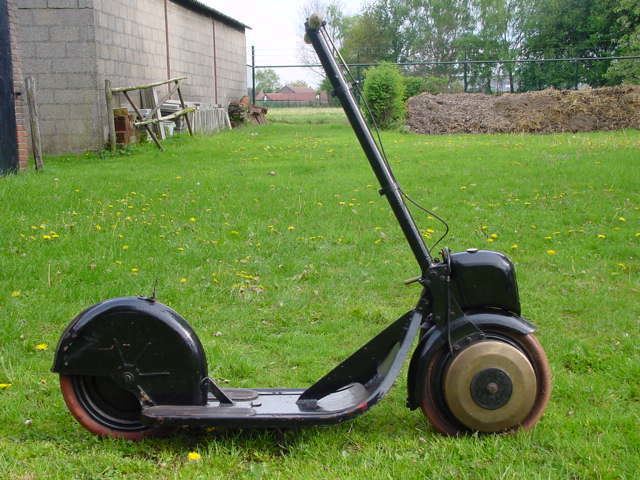 | ||
A motorized scooter or gas scooter is a small scooter designed to have the rider primarily in the standing position with a small motor attached. These scooters are generally designed with a large “deck” in the center on which the operator may stand. Gas powered stand-up scooters use a small utility engine (often designed for use in industrial power equipment) attached to the rear of the scooter. The first production scooter, the “Sport,” was released by Go-Ped in 1985. Since then, the industry has exploded with the creation of many new brands and technologies.
Contents
History
Usage
In addition to its usage for transportation, motorized stand-up scooters may be used in law enforcement, security, or patrolling.
Wheels and tires
There are two general categories of tires on which stand-up scooters travel—hard tires and air tires. Hard tires are generally six inches in diameter and constructed of a hard-plastic insert surrounded by a solid rubber tire. Air tires are most often 10 inches in diameter. They are constructed of a steel or aluminum split rim, an inner tube and rubber tire. Other, less common wheel and tire types include 8 inch and 13 inch air tires.
Transmissions
The most simplistic drive mechanism of stand-up scooters is the "spindle" drive. This drive mechanism puts an extension of the engine's output shaft, the spindle, in direct contact with the rear tire of the scooter. In order to function correctly, the tire must have a clean, dry surface which the spindle will be able to effectively interact with. Scooters with this type of direct transmission can be pull started with the rear wheel off of the ground or "bump" started by forcefully pushing the scooter with the rear tire in contact with the ground.
Simple chain reduction drives are also used to transfer energy to the rear wheel from the engine. These generally incorporate a type of centrifugal clutch to allow the engine to idle independently.
Belt reduction drives use the combination of wide flat "cog" belts and pulleys to transfer power to the rear wheel. Like chain drives, belt drives include a centrifugal clutch. Belt drives are more susceptible to breakage in off-road conditions.
Suspension
The suspension systems of stand-up scooters range from simplistic spring based fork systems to the complicated, dampened cam-link and C.I.D.L.I suspension mechanisms.
Legality
In many areas in the United States motorized scooters are not street legal, as they cannot be tagged, titled, insured, and do not meet simple federal requirements for lights or mirrors. Particular localitites may have further ordinances that limit the use of motorized scooters. The top speed of the average motorized scooters is around 20 miles per hour. Due to their small wheels motorized scooters are not typically safe for street use as even the smallest bumps can cause an accident.
For example, the state of California requires that a person riding a motorized scooter on a street must be 16 years of age or older, have a valid driver's license, be wearing a bicycle helmet, have no passengers, and otherwise follow the sames rules of the road the same as cars do. The motorized scooter must have brakes, may not have handlebars raised above the operator's shoulders, and if ridden at night must have a headlight, a taillight, and side reflectors. A motorized scooter may not be operated on sidewalks or on streets if the posted speed limit is over 25 mph, unless in a Class II bicycle lane.
